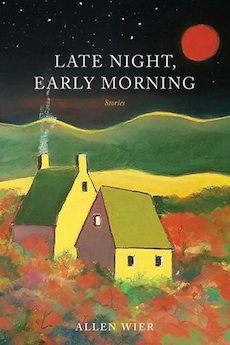By David Madden
Having admired Allen Wier’s fiction for almost four decades, it is a privilege and a pleasure to read his short stories again and fervently to recommend them.
Wier writes slowly, but from the beginning of his career, praise has come quickly and held fast, from the first novel and stories when he was only 32, published simultaneously and reprinted later, Blanco and Things About to Disappear. Three novels followed: Departing as Air; A Place for Outlaws; and his masterwork, the gigantic novel Tehano.
Wier has clearly taken great care in selecting and arranging the 22 stories in this second collection, which includes all the stories in his first, six uncollected stories, some of them recent, and seven stories that became part of his three novels later on. For this collection, he has lightly revised a fair number of them.
Given, as in this case, artistic excellence and pure reader interest, story collections usually benefit from variety, and various types of variety is a strong feature of Wier’s collection. His distinctive stylistic voice hovering over all, the stories vary greatly as to character, conflict, setting, and technique.
Although most of his characters are male, young and old, their relationships render female characters, young and old, very much alive.
Texas and the South are the settings that most stimulate his imagination. His conceptions are offbeat, but there are enough elements to satisfy conventional expectations. While among the stories there is a goodly balance of external and internal conflicts, Wier breathes life into dramas of consciousness, verging, but sometimes veering, into the magical, the mystical, or the metaphysical.
A distinctive feature of Wier’s fiction is his that his characters express an affectionate indulgence in the images, artifacts, and sayings of folk and popular culture. “The catsup makes me think of movie blood….” “It made Paul think of Jefferson’s invention of the dumb-waiter, the genuine pleasure in ingenuity.” “I’ve heard that hair and fingernails continue to grow” in the grave. Wier has let loose a flood of such enhancing allusions.
My own criteria for excellence in literature being aesthetic, I can testify to Wier’s mastery of techniques, such as point of view, dialog, the shifting use of tenses, and what I call the controlling charged image that beats at the heart of a story. Readers will experience thousands of breath-taking images.
In “Mr. Ollie, Think of the Baseball,” the reader’s experience is of Wier’s omniscient perspective on the commonplace game of baseball mixed, with a mystical vision, as it is central to the lives of three old men, with a focus on one of them—a good choice to open the collection.
Excellent word for word, “Everything’s Really Something” is one of the most poignant stories I have ever read of an ordinary man’s transient sexual experience with a very free-spirited young girl—“a fantasy realized.”
“Cambell Oakely’s Gospel Sun Shines on Roy Singing Grass” is a successfully complex story, set in Arkansas, involving some Native Americans, about the effect upon the protagonist and others of a fabled character, a cherished radio, and the workings of a loom.
“Things About to Disappear” provides another first person experience, but what needs most to be declared about this story is that it is quite simply one of the finest achievements of the form, with the reader being most aware of the richness of imagery. “Then the car rolled slowly over and fell gracefully across the ditch, hitting the soft mud with an ugly sound, someone breaking wind; a boil lanced; nose blown; phlegm spat. The windshield popped out whole and shot like a clipped fingernail across the ditch.” Teachers report that this story is their students’ favorite.
Reading his fiction, one can readily imagine that only by writing slowly, surely, could he have crafted such a confluence of fine sentences.
Over the years, the literary world has shown its regard for his achievement in major awards: inducted into the Fellowship of Southern Writers in 2003; the Robert Penn Warren Award for Fiction in 1997; and National Endowment for the Arts Fellowship. Not surprisingly, he has novels and short stories in progress.
Wier’s fiction is more akin to Virginia Woolf, Katherine Mansfield, James Joyce, and Wright Morris than Eudora Welty or Faulkner. Rare qualities difficult to describe are active in his sensibility. His is a meditative, lyrical imagination, but rhythms of thought, stylistic phrasing, and flowing imagery meshed with vivid action render it well paced.
David Madden (ΦBK, University of Tennessee, 1979) is the author of more than 50 books of fiction and nonfiction. Madden’s latest book is Marble Goddesses and Mortal Flesh: Four Novellas (University of Tennessee Press, 2017). He has finished My Creative Life in the Army.




